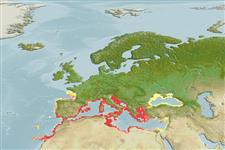>
Eupercaria/misc (Various families in series Eupercaria) >
Sparidae (Porgies)
Etymology: Diplodus: Greek, diploos = twice + Greek, odous = teeth (Ref. 45335).
More on author: Linnaeus.
Environment: milieu / climate zone / depth range / distribution range
Ekologi
laut; payau bentopelagis; kisaran kedalaman 0 - 90 m (Ref. 4781). Subtropical; 49°N - 27°N, 19°W - 42°E
Eastern Atlantic: Canary islands, also found along the coast of Portugal northward to the Bay of Biscay, Mediterranean, Black Sea and Sea of Azov (Ref. 4781).
Length at first maturity / Size / Weight / umur
Maturity: Lm 11.6, range 8 - 19.6 cm
Max length : 28.0 cm TL jantan/; (Ref. 124816); common length : 13.0 cm TL jantan/; (Ref. 3397); Berat maksimum terpublikasi: 330.00 g (Ref. 115876); Umur maksimum dilaporkan: 17 Tahun (Ref. 124518)
Duri punggung (Keseluruhan (total)): 11; duri punggung lunak (Keseluruhan (total)): 11-13; Duri dubur 3; Sirip dubur lunak: 11 - 12
Inhabit chiefly Zostera seagrass beds but also found on Posidonia beds and sandy bottoms, rarely on rocky bottoms. Carnivorous, feed on worms, crustaceans, mollusks, echinoderms and hydrozoans. The sexes are separated, although these fish are potential hermaphrodites; certain individuals are protandric (Ref. 4781).
Normally sexes are separate but some individuals are protandrous due to geographical variation in sexual pattern (Ref. 103751). However, histological studies confirm no degenerating functional tissue of one sex (e.g. vitellogenic or later-stage follicles) and no proliferation of tissue of the other sex can be found on this species indicating the absence of sex change. This particular condition is also known as nonfunctional hermaphroditism previously known as rudimentary hermaphroditism (Ref. 91314). Also Ref. 28504.
Bauchot, M.-L. and J.-C. Hureau, 1990. Sparidae. p. 790-812. In J.C. Quero, J.C. Hureau, C. Karrer, A. Post and L. Saldanha (eds.) Check-list of the fishes of the eastern tropical Atlantic (CLOFETA). JNICT, Lisbon; SEI, Paris; and UNESCO, Paris. Vol. 2. (Ref. 3688)
Status IUCN Red List (Ref. 130435)
ancaman kepada manusia
Harmless
penggunaan manusia
Perikanan: komersial; Ikan buruan: ya
informasi lanjut
AcuanBudidaya airprofil budidaya airStrainGenetikaElectrophoresesDiturunkanPenyakit-penyakitPengolahanNutrientsMass conversion
mitraGambarStamps, Coins Misc.Suara-suaraCiguateraKecepatanTipe renangArea insangOtolithsOtakPenglihatan / visi
Alat, peralatan
laporan khas
muat turun XML
Sumber internet
Estimates based on models
Preferred temperature (Ref.
123201): 14.8 - 21.1, mean 18.3 °C (based on 220 cells).
Phylogenetic diversity index (Ref.
82804): PD
50 = 0.5000 [Uniqueness, from 0.5 = low to 2.0 = high].
Bayesian length-weight: a=0.01202 (0.01093 - 0.01323), b=3.07 (3.05 - 3.09), in cm total length, based on LWR estimates for this species (Ref.
93245).
Trophic level (Ref.
69278): 3.6 ±0.0 se; based on diet studies.
Generation time: 4.5 (2.4 - 6.4) years. Estimated as median ln(3)/K based on 18
growth studies.
Daya lenting (Ref.
120179): sedang, Waktu penggandaan populasi minimum 1.4 - 4.4 tahun (K=0.2-0.5; tmax=7; Fecundity=18,000 - 212,000).
Prior r = 0.75, 95% CL = 0.50 - 1.13, Based on 4 stock assessments.
Fishing Vulnerability (Ref.
59153): Moderate vulnerability (36 of 100).
Climate Vulnerability (Ref.
125649): Moderate vulnerability (36 of 100).
Nutrients (Ref.
124155): Calcium = 83.2 [48.2, 160.3] mg/100g; Iron = 0.984 [0.561, 1.738] mg/100g; Protein = 19.3 [18.4, 20.3] %; Omega3 = 0.427 [0.224, 0.818] g/100g; Selenium = 23.7 [11.6, 43.4] μg/100g; VitaminA = 20.1 [6.8, 55.9] μg/100g; Zinc = 1.06 [0.72, 1.48] mg/100g (wet weight);
